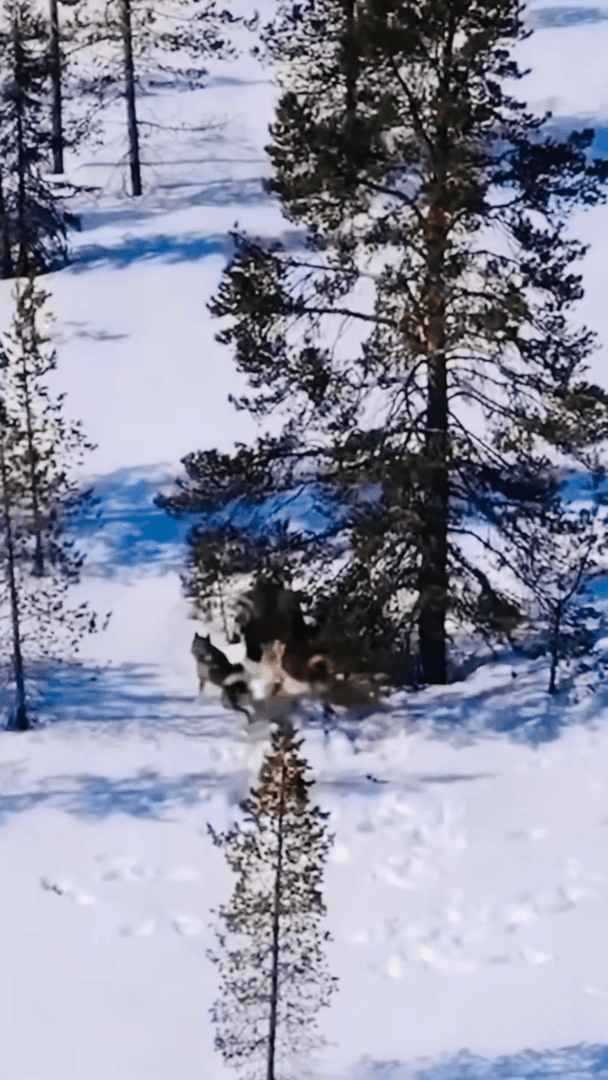Laika - All
Bear hunting with Laika ( Russian husky )
On this video shown the most correct, typical LAIKA work (hunt) on a bear.
The Russian word LAIKA (лайка) is a noun derived from the verb layat' (лаять, to bark), and literally means barker. As the name of a dog variety, it is used not only in Russian cynological literature, but sometimes in other languages as well to refer to all varieties of hunting dogs traditionally kept by the peoples of the northern Russia and adjacent areas.
Laikas are aboriginal spitz from Northern Russia, especially Siberia but also sometimes expanded to include Nordic hunting breeds. Laika breeds are primitive dogs who flourish with minimal care even in hostile weather. Laika is a universal breed of hunting dog. Generally, laika breeds are expected to be versatile hunting dogs, capable of hunting game of a variety of sizes by treeing small game, pointing and baying larger game and working as teams to corner bear and boar. However a few laikas have specialized as herding or sled dogs.
On this video shown the most correct, typical lakes’ work on a bear. The most successful will be only with two or three laika, of course, provided they are vicious and viscous. With this number, the division of labor is perfectly carried out: one laika attacks from the front and thereby distracts the attention of the beast; others, attacking from the flanks, seize convenient moments and, flying up with lightning speed, give a grip. When the dog is in the grip, the beast always turns instantly, like a spring, in order to catch the enemy in the rear, and thereby opens its rear to others. The grip of the new dog repeats, and again the bear instantly turns back.
Laika that works confidently and efficiently on a bear is the dream of any Russian Hunter. There are such dogs, but they are few. Let's try to figure out why not all dogs become bear-hunters.
There more than 30 deferent laika breeds in Russia for now. Since well-known bear hunter, Prince Shirinsky-Shikhmatov first cataloged 13 breeds of laikas: Zyryan, Finno-Karelian, Vogul, Cheremis, Ostyak, Tungus, Votyak, Galician, Norvegian, Buryatian, Soyotian, Laplandian and Samoyed Laika in the beginning of 20th century.
All Laika breeds in Russia are divided into three large groups: Hunting Laika, Herding Laika, Sled Laika
These breeds commonly recognized in Russia as Hunting Laikas: East Siberian Laika, Finnish Spitz, Karelian Bear Dog, Karelo-Finnish laika, Russo-European Laika, West Siberian Laika.
Bear hunting
Hunting bears is a thrilling yet demanding pursuit that requires careful planning and respect for nature. Several methods are employed to increase the chances of a successful hunt. One popular technique is hunting over oats, where hunters attract bears with bait. Another effective method is hunting from a tower, allowing for a broader view and improved accuracy. Utilizing trained Laikas can also enhance tracking, as these dogs are excellent companions in the field.
Many hunters choose to hunt during the night, when bears are more active, while hunting over bait remains a common practice. The bear hunting season varies by region, so it's crucial to verify local regulations.
When it comes to weaponry, rifles and shotguns are often preferred, with proper caliber selection critical to ensure a humane kill. Safety is paramount; always wear appropriate gear, inform others of your hunting plans, and carry bear spray as a precaution.
Remember to adhere to hunting rules: obtain necessary permits, respect wildlife habitats, and follow ethical practices to ensure sustainability. By observing these guidelines, hunters can enjoy the thrill of bear hunting while preserving the environment for future generations.
Another integral aspect of bear hunting is understanding bear behavior. Knowledge of a bear's feeding patterns, denning habits, and seasonal movements will significantly increase the likelihood of a successful hunt. Bears are generally most active during dawn and dusk, making these times ripe for hunting. Additionally, being aware of environmental factors such as weather conditions and food availability can influence bear activity and movement.
Preparation is key. Scouting the hunting area prior to the season allows hunters to identify signs of bear activity, such as tracks, droppings, and tree rubs. This information is vital for determining optimal bait sites and establishing hunting locations. Utilizing trail cameras can also provide insight into bear behavior and patterns, allowing hunters to plan accordingly.
Moreover, teamwork can be beneficial in bear hunting. Hunting with experienced partners enables effective communication and ensures safety in the field. Sharing knowledge and experiences also enriches the hunt. As an age-old tradition, bear hunting can foster camaraderie and a deeper appreciation for nature.
Ultimately, responsible bear hunting not only brings excitement and adventure but also emphasizes the importance of conservation. By treating each hunt with care and respect for wildlife, hunters contribute to the sustainable management of bear populations and their habitats.


